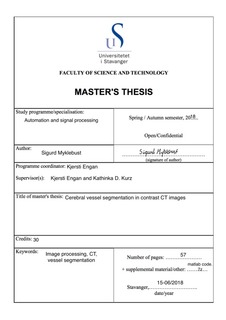Cerebral vessel segmentation in contrast CT images
Master thesis
Permanent lenke
http://hdl.handle.net/11250/2564754Utgivelsesdato
2018-06-15Metadata
Vis full innførselSamlinger
- Studentoppgaver (TN-IDE) [835]
Sammendrag
Patients with cerebral stroke symptoms are typically examined using CT scanning due to its availability and efficiency. If the stroke is suspected to be ischemic, a contrast agent is injected to increase the contrast in the brain. Several images are acquired as the contrast enters the brain. This accentuates the vessels and shows how the contrast distributes in the brain. This helps to locate the stroke and the tissue that is affected by it, i.e. if is in risk of getting or already is irreversibly damaged.
This thesis uses contrast CT images of 11 stroke patients. The images are registered, and methods to remove skull and find vessel segments are developed and evaluated. The skull is removed by using wavelet coefficient decomposition to detect edges, and then perform thresholding and watershed segmentation to isolate the brain. To detect the vessel segments, two methods are implemented. One uses adaptive thresholding and the other uses unsupervised clustering based on the features that are typical for vessel segments. Both the skull removal and the vessel segmentation have visually been shown to be promising.
Beskrivelse
Master's thesis in Automation and signal processing
